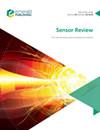不同加固方法对涡流阵列传感器裂纹监测特性的比较
IF 1.4
4区 工程技术
Q3 INSTRUMENTS & INSTRUMENTATION
引用次数: 0
摘要
目的研究不同加固方法对涡流阵列传感器裂纹监测特性的影响,提出了SUS304和坡莫合金两种不同加固方法的传感器。设计/方法/方法首先,建立传感器的有限元模型,分析补强板的电磁参数对裂纹识别灵敏度的影响。然后,采用两种加固方法对传感器的裂缝监测精度进行了测试。最后,分别进行了螺栓拧紧力矩为45和63N·m的疲劳裂纹监测实验。研究发现,通过提高补强板的相对渗透性,可以提高传感器的裂纹识别灵敏度。采用两种不同加固方法的传感器的裂缝监测精度约为1 并且坡莫合金增强板增强的传感器的裂纹识别灵敏度显著高于SUS304增强板增强传感器。独创性/价值加固板加固的传感器在螺栓的挤压作用下可以正常工作,使用相对渗透率高的加固板可以显著提高传感器的裂纹监测灵敏度。本文章由计算机程序翻译,如有差异,请以英文原文为准。
Comparison of different reinforcement methods on crack monitoring characteristics of eddy current array sensor
Purpose
This paper aims to study the influence of different reinforcement methods on crack monitoring characteristics of eddy current array sensors, and the sensors with two different reinforcement methods, SUS304 reinforcement and permalloy reinforcement, are proposed.
Design/methodology/approach
First, the finite element model of the sensor is established to analyze the influence of the reinforcement plate’s electromagnetic parameters on the crack identification sensitivity. Then, the crack monitoring accuracy test of sensors with two reinforcement methods is carried out. Finally, the fatigue crack monitoring experiments with bolt tightening torques of 45 and 63 N · m are carried out, respectively.
Findings
In this study, it is found that the crack identification sensitivity of the sensor can be improved by increasing the relative permeability of the reinforcement plate. The crack monitoring accuracy of the sensors with two different reinforcement methods is about 1 mm. And the crack identification sensitivity of the sensor reinforced by permalloy reinforcement plate is significantly higher than that of the sensor reinforced by SUS304 reinforcement plate.
Originality/value
The sensor reinforced by reinforcement plate can work normally under the squeezing action of the bolt, and the crack monitoring sensitivity of the sensor can be significantly improved by using the reinforcement plate with high relative permeability.
求助全文
通过发布文献求助,成功后即可免费获取论文全文。
去求助
来源期刊

Sensor Review
工程技术-仪器仪表
CiteScore
3.40
自引率
6.20%
发文量
50
审稿时长
3.7 months
期刊介绍:
Sensor Review publishes peer reviewed state-of-the-art articles and specially commissioned technology reviews. Each issue of this multidisciplinary journal includes high quality original content covering all aspects of sensors and their applications, and reflecting the most interesting and strategically important research and development activities from around the world. Because of this, readers can stay at the very forefront of high technology sensor developments.
Emphasis is placed on detailed independent regular and review articles identifying the full range of sensors currently available for specific applications, as well as highlighting those areas of technology showing great potential for the future. The journal encourages authors to consider the practical and social implications of their articles.
All articles undergo a rigorous double-blind peer review process which involves an initial assessment of suitability of an article for the journal followed by sending it to, at least two reviewers in the field if deemed suitable.
Sensor Review’s coverage includes, but is not restricted to:
Mechanical sensors – position, displacement, proximity, velocity, acceleration, vibration, force, torque, pressure, and flow sensors
Electric and magnetic sensors – resistance, inductive, capacitive, piezoelectric, eddy-current, electromagnetic, photoelectric, and thermoelectric sensors
Temperature sensors, infrared sensors, humidity sensors
Optical, electro-optical and fibre-optic sensors and systems, photonic sensors
Biosensors, wearable and implantable sensors and systems, immunosensors
Gas and chemical sensors and systems, polymer sensors
Acoustic and ultrasonic sensors
Haptic sensors and devices
Smart and intelligent sensors and systems
Nanosensors, NEMS, MEMS, and BioMEMS
Quantum sensors
Sensor systems: sensor data fusion, signals, processing and interfacing, signal conditioning.
 求助内容:
求助内容: 应助结果提醒方式:
应助结果提醒方式:


